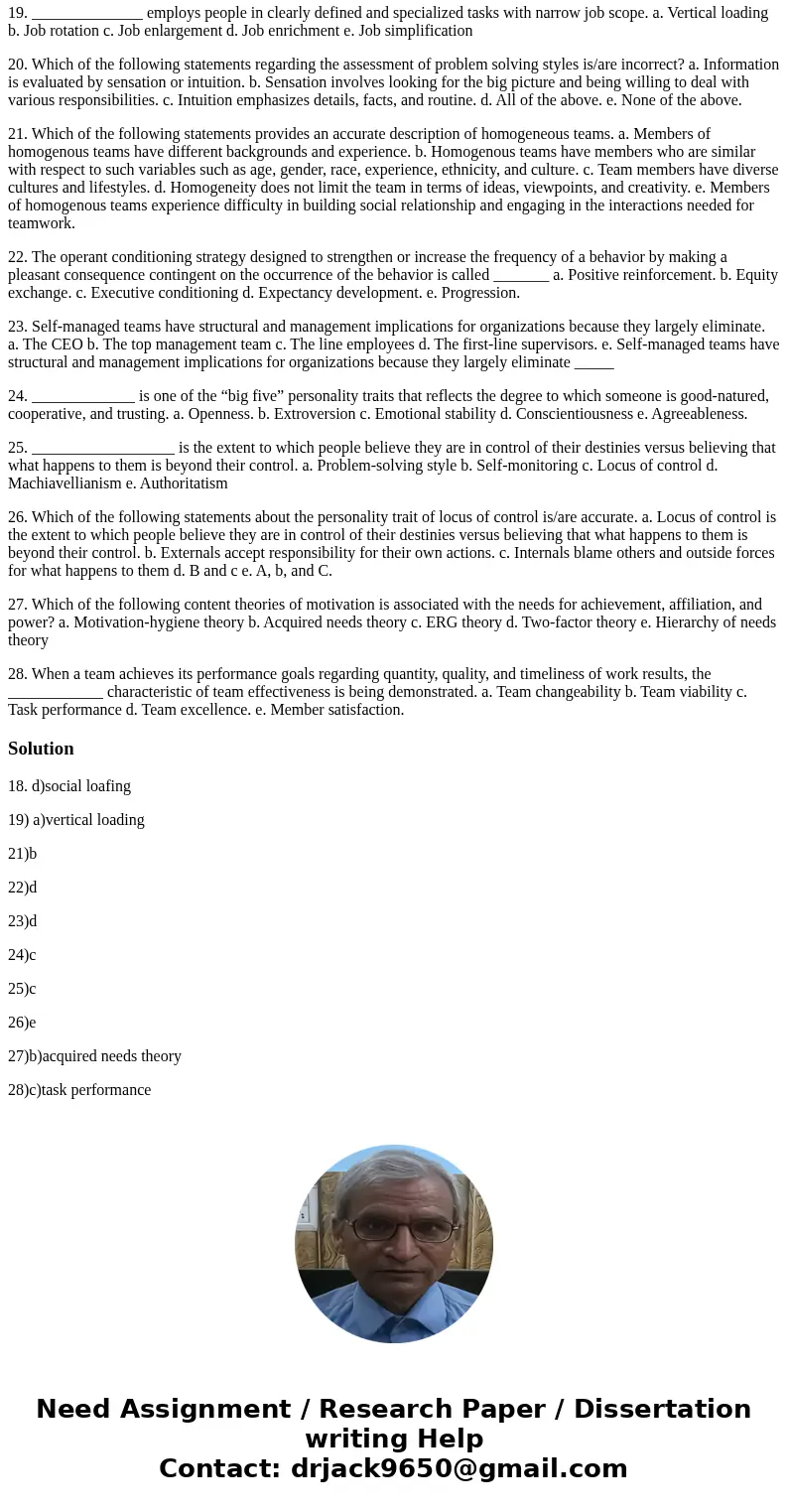18 refers to the presence of free riders who slack off beca
18. _______________ refers to the presence of “free riders” who slack off because responsibility is diffused in teams and others are present to the work. a. Social imperfections b. Poor work ethics c. Antisynergy d. Social loafing e. Synergy
19. ______________ employs people in clearly defined and specialized tasks with narrow job scope. a. Vertical loading b. Job rotation c. Job enlargement d. Job enrichment e. Job simplification
20. Which of the following statements regarding the assessment of problem solving styles is/are incorrect? a. Information is evaluated by sensation or intuition. b. Sensation involves looking for the big picture and being willing to deal with various responsibilities. c. Intuition emphasizes details, facts, and routine. d. All of the above. e. None of the above.
21. Which of the following statements provides an accurate description of homogeneous teams. a. Members of homogenous teams have different backgrounds and experience. b. Homogenous teams have members who are similar with respect to such variables such as age, gender, race, experience, ethnicity, and culture. c. Team members have diverse cultures and lifestyles. d. Homogeneity does not limit the team in terms of ideas, viewpoints, and creativity. e. Members of homogenous teams experience difficulty in building social relationship and engaging in the interactions needed for teamwork.
22. The operant conditioning strategy designed to strengthen or increase the frequency of a behavior by making a pleasant consequence contingent on the occurrence of the behavior is called _______ a. Positive reinforcement. b. Equity exchange. c. Executive conditioning d. Expectancy development. e. Progression.
23. Self-managed teams have structural and management implications for organizations because they largely eliminate. a. The CEO b. The top management team c. The line employees d. The first-line supervisors. e. Self-managed teams have structural and management implications for organizations because they largely eliminate _____
24. _____________ is one of the “big five” personality traits that reflects the degree to which someone is good-natured, cooperative, and trusting. a. Openness. b. Extroversion c. Emotional stability d. Conscientiousness e. Agreeableness.
25. __________________ is the extent to which people believe they are in control of their destinies versus believing that what happens to them is beyond their control. a. Problem-solving style b. Self-monitoring c. Locus of control d. Machiavellianism e. Authoritatism
26. Which of the following statements about the personality trait of locus of control is/are accurate. a. Locus of control is the extent to which people believe they are in control of their destinies versus believing that what happens to them is beyond their control. b. Externals accept responsibility for their own actions. c. Internals blame others and outside forces for what happens to them d. B and c e. A, b, and C.
27. Which of the following content theories of motivation is associated with the needs for achievement, affiliation, and power? a. Motivation-hygiene theory b. Acquired needs theory c. ERG theory d. Two-factor theory e. Hierarchy of needs theory
28. When a team achieves its performance goals regarding quantity, quality, and timeliness of work results, the ____________ characteristic of team effectiveness is being demonstrated. a. Team changeability b. Team viability c. Task performance d. Team excellence. e. Member satisfaction.
Solution
18. d)social loafing
19) a)vertical loading
21)b
22)d
23)d
24)c
25)c
26)e
27)b)acquired needs theory
28)c)task performance


 Homework Sourse
Homework Sourse